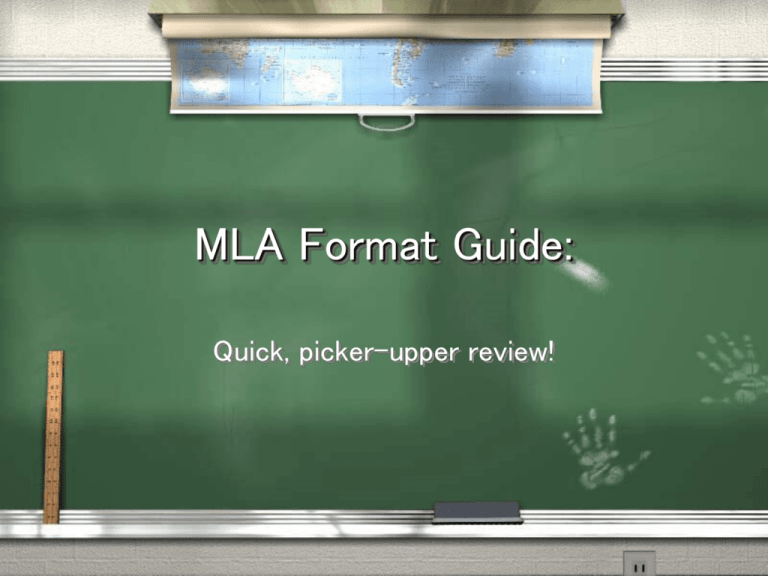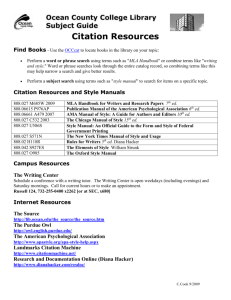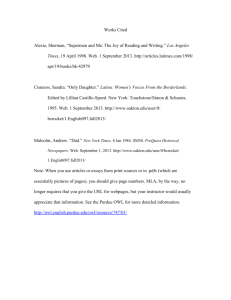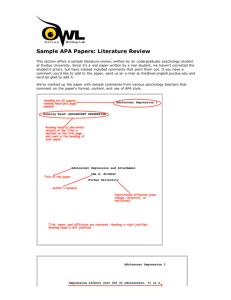MLA Format Guide - Nicholls State University
advertisement

MLA Format Guide: Quick, picker-upper review! A brief checklist: Have you * Used standard, white 8.5 by 11-inch paper? * Double-spaced and used an acceptable font? * Created a header, numbering the pages consecutively? * Italicized the titles of longer works? * Reviewed your instructor’s formatting directions??? Okay, enough with the preface! * Differing from other essays, a research paper requires you to, of course, research and cite sources. So let’s start with MLA in-text citations… * Parenthetical citations: If you don’t mention the writer’s name in your sentence, at the end, place the author’s name and the source’s page number inside parentheses (Dupré 1). * When you mention the author’s name in the sentence, then place only the relevant page number(s) in parentheses. Examples: 1.) Zeus, that codger, “bemoaned his aching back” (Homer 89). 2.) In his autobiography, Melville writes that his “favorite hue is a gentle, undulant rouge” (45). 3.) If the work has no author, then substitute the source’s shortened title for the anonymous author. Irregular Citations: A Brief and Close Look * Authors with same last name? Use first letter of first name to distinguish: (A. Goody 159) (B. Goody 157) * Multiple works by same author? Include shortened title in citation (Miller, Cancer 469). * Indirect source -- you quote the author quoting someone else -- then follow this format example: (qtd. in Comeaux 259). Formatting Quotations! * Periods, commas, and semicolons should appear after the parenthetical citation. * Question marks and exclamation points?! Inside the quotation marks if part of passage, but outside parenthetical citation if part of your text. * Mark breaks in short quotations of verse with a slash, /, at the end of each line of verse: * Cullen concludes, "Of all the things that happened there / That's all I remember" (11-12). Loooooong Quotations? * Quotation longer than four typed lines? Block it as such: Begin the block quotation on a new line, indenting one inch. The parenthetical citation follows the quotation, and you should omit the quotation marks. (Boo 2) Say What? * Need to omit or add word(s)? Then use brackets to indicate textual additions: According to Robertson, “Dr. Wily [who is actually a robot] is up to no good” (23). * If omitting words, then use ellipses: The dubious character explained “the reason we wear these bandanas is because […] we are zombies” (Bradstreet 90). Excited about Works Cited! * Your in-text citations refer readers to the Works Cited page, usually last in your manuscript, and give a source’s information. * Since you can research many resources, MLA thus provides various types of citations. Quick reminders: * Refer to instructor’s formatting directions for the Works Cited page! * Alphabetize your entries! * Capitalize each word in the titles of articles, books, etc, but do not capitalize articles, short prepositions, or conjunctions unless one is the first word of the title or subtitle: The Complete History of a Paperclip, Why Dinosaurs and Ninjas Are Awesome, There’s No Preposition I’d End a Sentence With. * Use italics for longer works, like books, but quotation marks for shorter ones, such as poems. * After the first line, indent all other lines of the citation. Books: * One author? Then use this example: Last name, First name. Title of Book. Place of Publication: Publisher, Year of Publication. * More than one author? Rodrigue, John, and Nick Comeaux. Poetic Geriatrics. New Orleans: Red Herring, 2007. * If more than three authors, after listing the first author, you may type “et al,” indicating other unmentioned authors. Coyne, Amanda, et al. * Two or more books by the same author? Write one regular entry, and for the additional ones, substitute “---” for the author’s name. List the author’s books alphabetically by title under his or her named entry. Books: * Corporate author? Italian-American Association. “The History of Jutz’s Café.” Thibodaux: Random, 2009. * No author at all? List work alphabetically by title, and follow this example: Encyclopedia of Indiana. New York: Somerset, 1993. • Translated book? Derrida, Jacques. Sovereignties in Question. Trans. Lindon Stall. Opelousas: Ditto Press, 2004. * Republished book? Insert the original publication date before the newer one: Falgoust, Kristina. On Blinking. 1981. Vacherie: Coin Books, 2002. Books: * Anthology or collection? List by editor. Melvin, Clay, ed. The Harrowing Lyrics of Early Dylan. New York: Viking Press, 2004. * If you have multiple editors, then use “eds.” * Work in an anthology of collection? Lastname, Firstname. “Title of Work.” Title of Anthology. Ed. Editor’s Name(s). Place of Publication: Publisher, Year. Pages. Periodicals: * Article in a magazine? Author(s). “Title of Article.” Title of Periodical. Day Month Year: pages. * Article in a newspaper? Cheramie, Janie. “Sudden Beaver Attack, Mayor Rothbard blames Wikipedia.” The New York Times. 23 June 2004: 10. * Article in a Scholarly Journal? Author(s). “Title of Article.” Title of Journal Volume. Issue (Year): pages. * Journal with continuous pagination? Allen, Emily. "Staging Identity: Frances Burney's Allegory of Genre." Eighteenth-Century Studies 31 (1998): 433-51. Non-continuous pagination? Then you must include the issue. Electronic Sources: Find these common features before you cite a web page: * Author and/or editor names * Name of database & title of project, book, or article * Any available version numbers * Date of version, revision, or posting * Publisher information * Date you accessed the material * Electronic address, printed between the carets ([< , >]) Electronic Sources: * An entire website? Name of Site. Date of Posting/Revision. Name of institution/organization affiliated with the site (often found in copyright statements). Date you accessed the site. [electronic address]. * The Purdue OWL Family of Sites. 26 Aug. 2005. The Writing Lab and OWL at Purdue and Purdue University. 23 April 2006 <http://owl.english.purdue.edu>. Electronic Sources: * A page on a site? ”Boudreaux’s Paste.” Wikipedia: The Free Encyclopedia. 28 April 2006. 10 May 2006 <http://en.wikipedia.org/wiki/Bpaste>. * Short work from site? Heidegger, Martin. “Let’s Get Metaphysical.” Anthology of Stuff. London: A. Bell, 1996. Online Cool Stuff. 17 May 2000. University of Importance. 09 November 2007 <http://urlistoolongsousethesiteshomepage.com>. More Electronic Sources An article in a web magazine? Author(s). "Title of Article." Title of Online Publication. Date of Publication. Date of Access <electronic address>. An article in an online scholarly journal? Wheelis, Mark. "Investigating Disease Outbreaks Under a Protocol to the Biological and Toxin Weapons Convention." Emerging Infectious Diseases 6.6 (2000): 33 pars. 8 May 2006 <http://www.cdc.gov/ncidod/eid/vol6no6/wheelis.htm>. One More Electronic Source, I Promise: * Article from an electronic subscription service? Grabe, Mark. "Voluntary Use of Online Lecture Notes: Correlates of Note Use and Note Use as an Alternative to Class Attendance." Computers and Education 44 (2005): 409-21. Science Watch. ScienceDirect. Nicholls, Thibodaux, Ellender Lib. 28 May 2006 <http://www.sciencedirect.com/>. And there you have it! Oh, one more thing. Here’s the citation for this presentation: The Purdue OWL Family of Sites. 26 Aug. 2005. The Writing Lab and OWL at Purdue and Purdue University. 23 April 2006 <http://owl.english.purdue.edu>.




